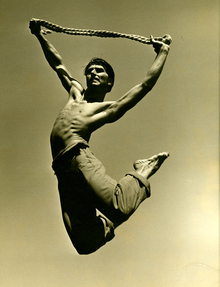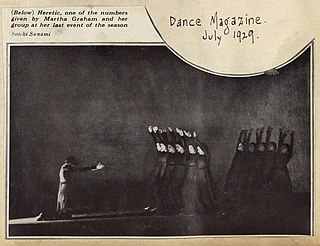
Mercier Philip "Merce" Cunningham was an American dancer and choreographer who was at the forefront of American modern dance for more than 50 years. He frequently collaborated with artists of other disciplines, including musicians John Cage, David Tudor, Brian Eno, and graphic artists Robert Rauschenberg, Bruce Nauman, Andy Warhol, Roy Lichtenstein, Frank Stella, and Jasper Johns; and fashion designer Rei Kawakubo. Works that he produced with these artists had a profound impact on avant-garde art beyond the world of dance.

Martha Graham was an American modern dancer and choreographer, whose style, the Graham technique, reshaped American dance and is still taught worldwide.

The American Dance Festival (ADF) under the direction of Executive Director Jodee Nimerichter hosts its main summer dance courses including Summer Dance Intensive, Pre-Professional Dance Intensive, and the Dance Professional Workshops. It also hosts a six-week summer festival of modern dance performances, currently held at Duke University and the Durham Performing Arts Center in Durham, North Carolina. Several site-specific performances have also taken place outdoors at Duke Gardens and the NC Art Museum in Raleigh, NC.
Marjorie Guthrie, who used Marjorie Mazia as her professional name, was a dancer, dance teacher, and health science activist. She was married to folk musician Woody Guthrie. Her children with him include folk musician Arlo Guthrie and Woody Guthrie Publications president Nora Guthrie.
Terese Capucilli is an American modern dancer, interpreter of the roles originally performed by Martha Graham. She is one of the last generation of dancers to be coached and directed by Graham herself. A principal dancer with the Martha Graham Dance Company for twenty-six years, she became associate artistic director in 1997 and from 2002 to 2005 served as artistic director, with Christine Dakin, seeing the organization and its dancers through the rebirth of the company. A driving force of Graham's work for nearly three decades, she is now Artistic Director Laureate.
Harvey Lichtenstein was an American arts administrator. He is best known for his 32-year tenure (1967–99) as president and executive producer of the Brooklyn Academy of Music, or BAM, as it became known under his leadership. He led the institution to a renaissance, championing contemporary performance, establishing the Next Wave Festival, and providing a vital venue for dance, theater, music, and collaborations that bridged disciplines. The long list of artists who came to perform on BAM's stages under Lichtenstein's purview reads like a Who's Who of 20th-century performance, and includes Laurie Anderson, Pina Bausch, Peter Brook, Merce Cunningham, Philip Glass, Meredith Monk, Jerzy Grotowski, Mark Morris, Steve Reich, Twyla Tharp, and Robert Wilson. When Lichtenstein retired, the Doris Duke Charitable Foundation made the decision to honor his considerable accomplishments by foregoing its own naming rights and dedicating the BAM Harvey Theater in his honor.

Frederick "Erick" Hawkins was an American modern-dance choreographer and dancer.

Modern dance is a broad genre of western concert or theatrical dance which includes dance styles such as ballet, folk, ethnic, religious, and social dancing; and primarily arose out of Europe and the United States in the late 19th and early 20th centuries. It was considered to have been developed as a rejection of, or rebellion against, classical ballet, and also a way to express social concerns like socioeconomic and cultural factors.
The Martha Graham Dance Company, founded by Martha Graham in 1926, is both the oldest dance company in the United States and the oldest integrated dance company. The company is critically acclaimed in the artistic world and has been recognized as "one of the great dance companies of the world" by the New York Times and as "one of the seven wonders of the artistic universe" by the Washington Post.

La hija de Cólquide is a ballet score composed by Carlos Chávez in 1943–44 on commission from the Elizabeth Sprague Coolidge Foundation for Martha Graham. The title refers to the mythological character Medea, daughter of King Aeëtes of Colchis, in the story of Jason and the Golden Fleece. The ballet spawned several subsidiary works in Chávez's catalog including his Third String Quartet. When Graham eventually choreographed it, she wrote a new scenario and gave it the title Dark Meadow.

Graham technique is a modern dance movement style and pedagogy created by American dancer and choreographer Martha Graham (1894–1991). Graham technique has been called the "cornerstone" of American modern dance, and has been taught worldwide. It is widely regarded as the first codified modern dance technique, and strongly influenced the later techniques of Merce Cunningham, Lester Horton, and Paul Taylor.
Deaths and Entrances is a ballet choreographed by Martha Graham performed to music by Hunter Johnson. Arch Lauterer created the original set; Edythe Gilfond designed the costumes. The ballet was well-received from the first performance despite being labeled as one of Graham's most personal, least accessible works. Oscar de la Renta created new costumes for the ballet's 2005 revival. The piece premiered on July 18, 1943, at Bennington College in Bennington, Vermont. The first performance was an informal preview for which the dancers wore practice clothes although the set was in place.
Punch and the Judy is a comic ballet about marital discord choreographed by Martha Graham to music by Robert McBride. Arch Lauterer designed the set, Charlotte Trowbridge, the costumes. Edward Gordon Craig provided text for the narrated portions. The piece premiered on August 10, 1941, at the Bennington College Theatre in Bennington, Vermont.
American Document is a modern dance work choreographed by Martha Graham in response to rising Fascism in 1930s Europe. The piece premiered on August 6, 1938 at the Vermont State Armory in Bennington, Vermont. The ballet features spoken word excerpts from the Declaration of Independence and Emancipation Proclamation, among other texts. The set was created by Arch Lauterer; the costumes were designed by Edythe Gilfond. The original music was written by Ray Green. Graham extensively reworked the choreography in 1989. John Corigliano's Oboe Concerto replaced Green's music for the revised version.
Imagined Wing is a ballet choreographed by Martha Graham to Jeux de Printemps by composer Darius Milhaud. The piece was first presented on October 30, 1944, in the Elizabeth Sprague Coolidge Auditorium at the Library of Congress, Washington, D.C. Costumes were designed by Edythe Gilfond; the set was created by Isamu Noguchi. Elizabeth Sprague Coolidge commissioned the work, along with two other Graham dances, and musical scores for all three dances. Also on the program were Mirror Before Me set to music by Paul Hindemith and Appalachian Spring performed to music by Aaron Copland. Imagined Wing's initial showing was also its last. Following tepid reviews, the piece was never performed again.

Heretic is a modern dance work by Martha Graham performed to Tetus Breton, an old folk tune from Brittany. Louis Horst, Graham's musical director, recommended the song, part of the collection Chansons de la Fleur de Lys as arranged by Charles De Sivry. The dance premiered with the title Heretic at New York's Booth Theatre on April 14, 1929. In a previous program announcement, the work was called A Faith. Graham presented the piece with her company; the performance marked the debut of her concert ensemble. Heretic is staged for 13 female performers, 12 dressed in black tube-like garments and one in a long white dress. Dancers for the premiere were: Graham, as the woman in white, Kitty Reese, Louise Creston, Irene Emery, Ethel Rudy, Lillian Ray, Hortense Bunsick, Sylvia Wasserstrom, Mary Rivoire, Ruth White, Lillian Shapero, Virginia Briton, Sylvia Rosenstein, Evelyn Sabin, Betty Macdonald and Rosina Savelli.
El Penitente is a modern dance work by Martha Graham performed to music by Louis Horst. It premiered on August 11, 1940, at the Bennington College Theater, Bennington, Vermont, with costumes by Edythe Gilfond and a set by Arch Lauterer. Isamu Noguchi later redesigned the set and created a new mask.
Land Be Bright is a modern dance work choreographed by Martha Graham to music by Arthur Kreutz with a set and costumes by Charlotte Trowbridge. The unabashedly patriotic piece premiered on March 14, 1942, at Chicago's Civic Opera House. The original cast included Graham and members of the Martha Graham Dance Company.
Chronicle is a modern dance work choreographed by Martha Graham to music by Wallingford Riegger. It premiered on December 20, 1936, at the Guild Theatre in New York City. The set was designed by Isamu Noguchi. Riegger's music was scored for piano, wind instruments and percussion; Noguchi's set was made up primarily of curtains, platforms and stairs. The original production was danced by Martha Graham and Group, the forerunner of the Martha Graham Dance Company. According to the program notes, the dance is based upon "the advent and consequences of war" and concerned itself with the "contemporary situation", referring to the impending conflict in Europe.
American Lyric was a modern dance work choreographed by Martha Graham to music of Alex North with costumes by Edythe Gilfond. The piece premiered on December 26, 1937, at the Guild Theatre in New York City. The ballet was subtitled Dance of Assembly. In some programs, the work also included the statement, "This dance has as its theme the basic American right—freedom of assembly."







